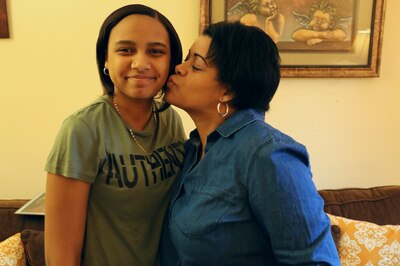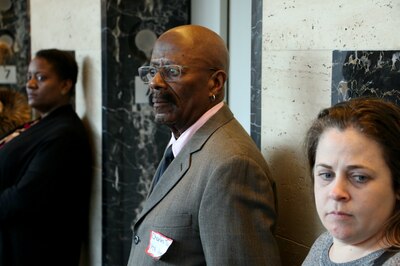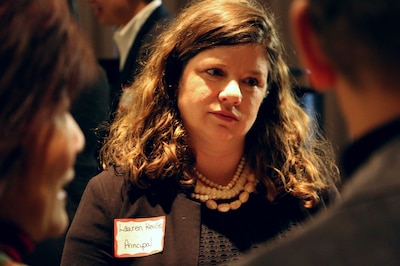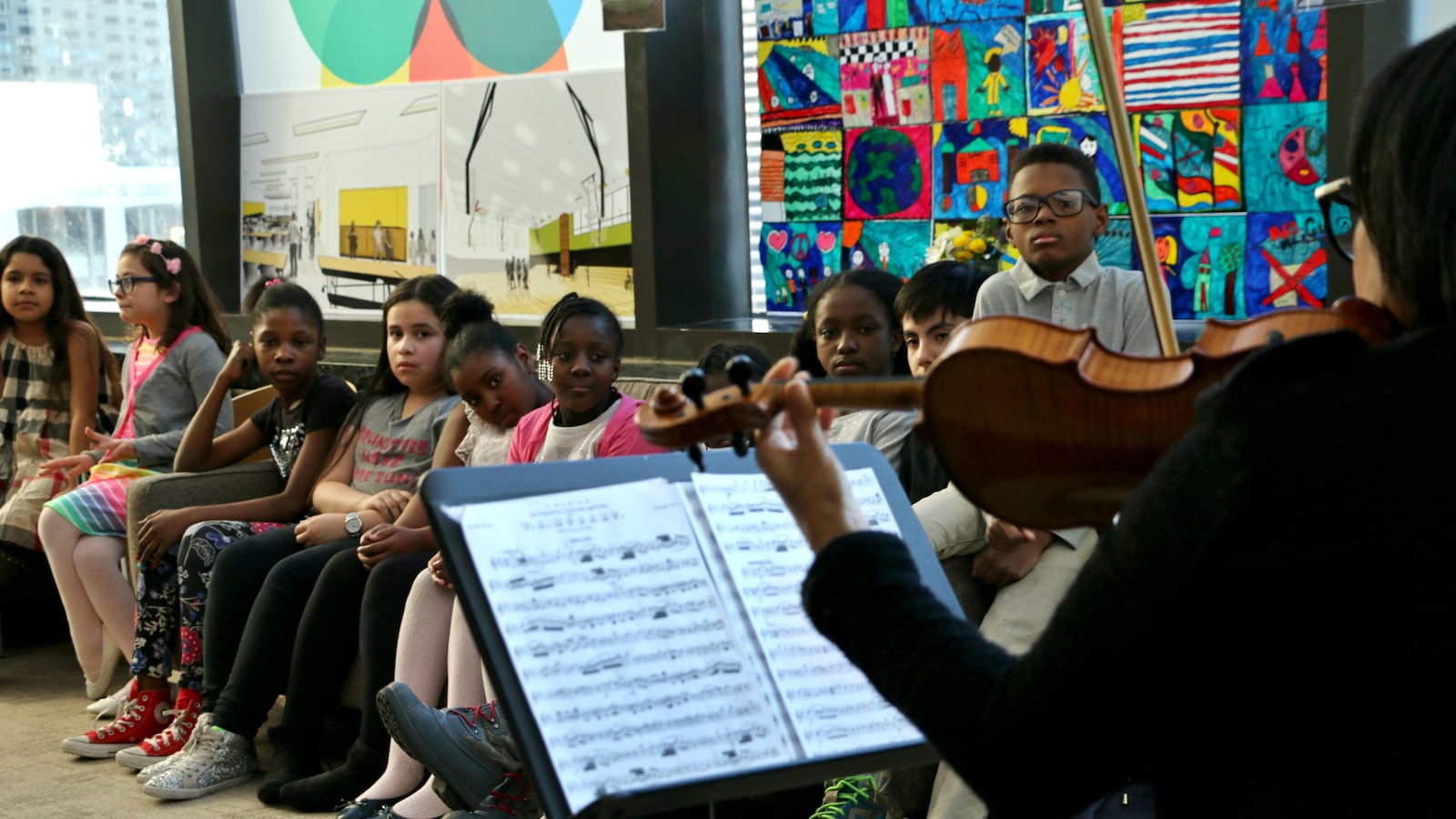This summer, P.S. 191 on the Upper West Side will move into a new space inside a gleaming condominium tower overlooking the Hudson River. It’s an extraordinary new chapter for a school that has come to symbolize the city’s stark racial and class divisions and its halting attempts at integration.
The move follows a bitter debate over the city’s plan to reduce overcrowding at highly sought-after P.S. 199 by shifting some families to the zone of P.S. 191, which has lower test scores and was previously designated “persistently dangerous” by the state. The plan spotlighted the chasm between schools located just nine blocks apart: P.S. 199 is disproportionately white and Asian with a PTA that rakes in $800,000 annually, while P.S. 191 is overwhelming black and Hispanic and serves many children from the public-housing development across the street, called the Amsterdam Houses. The plan was approved in November, though it remains to be seen how many rezoned families will enroll at 191 or seek alternatives.
The rezoning battle was remarkable not just for its rancor, but also for how closely it mirrored the fight that erupted a half-century earlier when the city tried to integrate the same two schools. In 1964, the city proposed “pairing” the racially segregated schools so that students from their combined zones would attend 191 for the early grades and then transfer to 199. After opponents failed to block the plan, many white families abandoned the public schools entirely.
To mark the end of P.S. 191’s current chapter, Chalkbeat interviewed current and former parents, students and staffers to compile an oral history of its integration struggles, past and present. The interviews were conducted from fall 2016 to early 2017.
Just like today, the 1964 zone change was preceded by a series of public hearings. Most P.S. 199 parents railed against the pairing plan, but a small group of white families — many of them residents of the Lincoln Guild co-op building, like the women quoted below — supported it and sent their children to both schools.
Anita Stark: There were dozens and dozens of meetings. The pairing caused a great split in this neighborhood. Tremendous split. There were those who supported the pairing, and there were those who were ardently against it, and they just stopped talking to each other.
Bernice Silverman: All these upper-income articulate professionals would shout. They couldn’t control their anger; they couldn’t wait their turn. It’s not tolerated in kindergarten, but when you’re grown up you can do it.
Yvonne Pisacane: Once it was clear who was going to support it and who was against it, people didn’t talk to each other. You just didn’t talk. People walked past each other as if they didn’t know each other. I tell you the truth, it was much uglier on the adults’ part than the kids’.
Stanley Becker, P.S. 191’s principal from 1960 to 1980: You got the same situation with the pairing as we have now [with the rezoning hearings]. Parents from 199 got up at school-board meetings and said, “I bought this home for $200-, $300-, $400,000 dollars so I could watch my kid go to school and come home. I don’t want him on a bus going down to another school.”
Later, he said, he saw some of those same parents send their children on buses to private schools in other parts of the city rather than to P.S. 191.
Oh, so the parents who didn’t want their kids to go 10 blocks by bus to a local school had no objection to them going half an hour to the Bronx? You understand that this was just a guise. They don’t want their kids sitting in a school with black and Hispanic kids. That’s the bottom line.
Stark: There were a lot of white parents who really had some racist feelings about the pairing, but they were not going to admit to that. They were going to say there were 13 other reasons they rejected it.
Silverman: There were two things that white parents said: One, they didn’t want — if you mix levels of intelligence or acquired knowledge, it raises the level of the lower group — they didn’t want their kids to be the teachers, to be used as guinea pigs. And the other thing, I guess just fear of poor black people. I don’t know if people said it, but they were afraid there’d be thefts, that the black kids would beat up white kids.
The few white families who supported the pairing enrolled their children at P.S. 191. Students who were unlikely to have crossed paths outside of school became classmates. To help them bond, Principal Becker organized relay races during lunch.
Kenneth Birnbaum, who grew up in Lincoln Guild, said the relay races “transformed” his experience: Being pretty alone, feeling like a minority, scared a lot of the time, to sort of finding my way in this school and making friends with all these people. … The people I was scared of got to be some of my best friends.
Some of the students extended their friendships beyond school, including in the Amsterdam Houses community center.
Robert Stark, Anita’s son: So many of my friends were in the projects. We used to hang out, build models together [ in the community center]. I took a woodshop class there. We took dancing. … It was pretty racially mixed.
Valerie Washington, who grew up in the Amsterdam Houses, made friends with a girl who lived on Central Park West: I remember going to her house. Wow. She had a party. I’ll never forget that, I was impressed … Those apartments were huge. You took an elevator and it’s just your apartment on the floor.
Chris Pisacane, Yvonne’s son: I will say this, I know from going to those schools with those kids that it made me a better person. That I am 100 percent sure of. … Overall, it was a very good experience. And I think it would be a good experience now if it was like that.
The pairing is believed to have officially ended in the 1980s, but by that time white families had almost entirely stopped enrolling at P.S. 191. The school had returned to serving nearly all black and Hispanic students, many of whom lived in poverty.
Gladys Curet, a former 191 student, taught at the school from 1982 to 2011: I saw the change in the kids, and the lack of support from the system. The need for more and getting less. I say that money-wise, supplies, support … I remember once having 34 kids. I took it on. I said I could do this. … But it wasn’t fair to them. I literally had kids sitting on the windowsill.
Even as P.S. 191 struggled, its neighbor, P.S. 199, thrived. Today, it’s one of the city’s top-performing elementary schools and its PTA is among the highest grossing. Their students rarely interact, but last year fifth-graders at the two schools teamed up for a service project. They made peanut butter-and-jelly sandwiches for hungry New Yorkers.

Stacie Lorraine, a P.S. 191 teacher: So everyone was just mixed up together and given this task. And they were all working together and having so much fun and really enjoying each other. These were kids who live in the same neighborhood. Some of them knew each other because they’d been to camp together or had seen each other in other places. And it was such a beautiful moment of what could be. … Then we all go home.
The city first proposed the P.S. 191-199 rezoning in October 2015. The subsequent hearings were dominated by parents in P.S. 199’s zone who opposed the plan.
Susannah Blum, a P.S. 191 teacher: At the last zoning meeting at our school, someone got up and said, “This is very unfair to have on a Saturday meeting.” I’m thinking, “My God, this is probably the only time that some of our parents can come.” … They’re fighting more for their survival and their lives and their financial stability than some of the families from 199.
Joselin Santana, a P.S. 191 parent who lives in the Amsterdam Houses and works as a home-health aide: I work 12-hour days, 7 to 7 … I come home, I do cooking, I have to watch if [her daughter, Aaliyah] has homework, if she does it. If I don’t tell her, sometimes she forgets because she’s too busy, she’s at basketball. I say, “No, no, no.” … I have to be sure she takes her shower, she’s eating, she does her homework, and everything.
Lorraine: I don’t want to speak for our families, but they probably feel marginalized in this whole process. When they do come to the meetings, they’re listening to people say only slightly concealed racist things.
Yvette Powell, a P.S. 191 grandparent who lives in the Amsterdam Houses: I heard one parent say they didn’t want their children with these children. They don’t want what these children do to rub off on their children. And I’m like, these are all children.

Charles Taylor, president of P.S. 191’s parent-teacher association: It’s saying, “We don’t want our kids with your kids.” That’s the message. It doesn’t matter how the message is packaged. That’s the message. It may not even be the intent. I can’t say what people are actually feeling when people are advocating for their own children. I can certainly understand that. But that’s not the way it sounds to the people that you don’t want your children to be with.
Lauren Keville, P.S. 191’s principal: The thing that was hardest for me to hear was when people made judgements about our kids. Because our kids are amazing. And so, you know, that’s hard to take. But what I would say to our parents, “This is not the opinion of all. … We know how great our school is.”
Fernando Taylor, Charles’s son, who is in seventh grade: There’s no bullying in our school. There’s no gossiping in our school. It’s just a really nice school.
Sandra Perez, P.S. 191’s assistant principal, said she warned her older students that outsiders might make assumptions about the school based on their behavior: That’s hard. They don’t understand that. They’re like, “I’m just being a kid.” Yeah, I’m sorry, but everybody’s watching us. For years that I was here, nobody ever looked at us twice. No one ever visited. No one cared. And all of a sudden, now schools are overcrowded, and they need our building. All of a sudden, we matter.
Powell said the rezoning battle reminded her of other interactions in the neighborhood.

Powell: I go to Riverside Drive [playground] and the kids start playing together. It’s the parents. The parents go, “Get over here.” My granddaughter’s like, “Why can’t she play with me?” I said, “Maybe they’re going home.” … I don’t want my granddaughter to know what’s going on yet. She’s going to know, but not yet.
Aaliyah Santana, Joselin’s daughter, who is in eighth grade: People get scared of other races. That’s probably because they haven’t been near other races. They’ve probably just been near their race. So when they go to a new job or a new school and there’s different races, they’re like, “Oh my God.” I think that would [get better] if there was more diversity.
Elena Nasereddin, a former P.S. 191 principal who left in 2003, said she hopes parents who were rezoned for 191 will consider enrolling: I would be ecstatic if this opportunity were to be seized by a group of parents who are progressive and who believe in equal opportunity. Who believe that black lives matter, that brown lives matter. Working together, they can make that a wonderful school.

